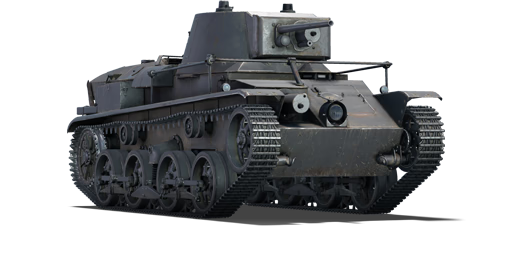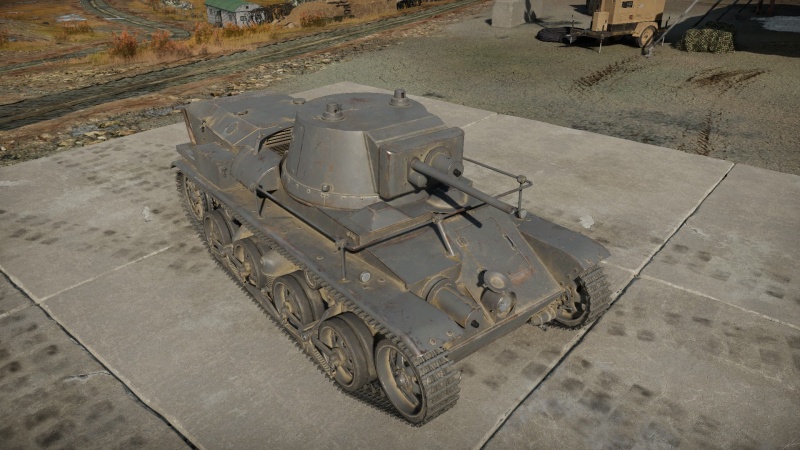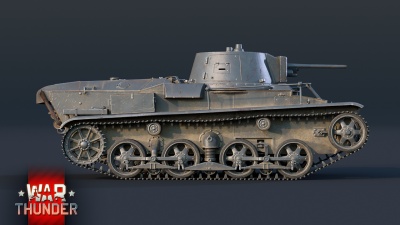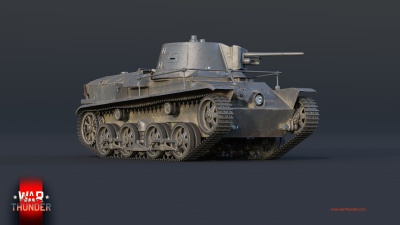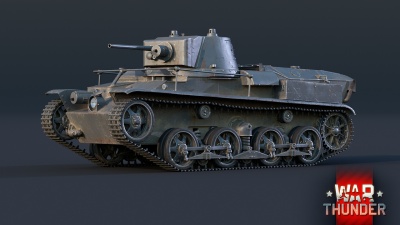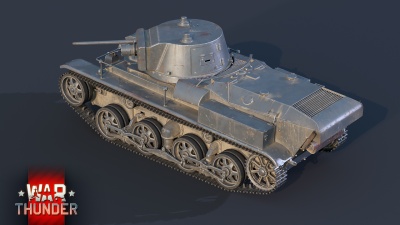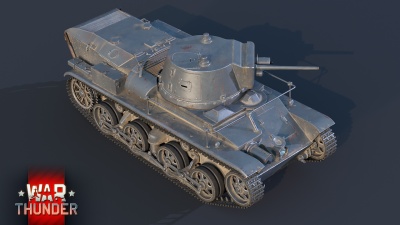Difference between revisions of "Strv m/31"
CobraKingII (talk | contribs) (→History) (Tag: Visual edit) |
(→History) |
||
| Line 174: | Line 174: | ||
== History == | == History == | ||
| − | + | Strv m/31 were designed during the 1930's after a continuation development of the german Joseph Vollmer had designed, When the germans took over AB Landsverk in 1920 they had a idea of a band and wheeled armored vehicle. Which during that time were not allowed to be developed according to the treaty of treaty of versailles. From the design and idea Joseph Vollmer had in Berlin, This idea would continued to be devloped in Sweden using AB Landsverk 1930, The tank would be designated L-30 by Landsverk and next to development of the L-30 which both had wheels and tracks there was a purely tracked model of the tank which would be designated L-10. | |
| + | |||
| + | AB Landsverk got an order from KAF in Autumn 1931 to build one L-30 and three L-10 for trials after a in-depth analysis of the vehicles where the L-30 and L-10 would get extensive trials. L-30 and L-10 which shares the same construction would both be designated Strv m/31 but the L-30 would be designated fm/31. L-30 when it was ready from the AB Landsverk in 1935 after alot of delays was considered to be to unmodern and all the advanced tech that had been put into it would make it to vulnerable to have since during the time Tracks had become stronger and suspension system alot more comfortable in tanks, which favored the L-10 instead. | ||
| + | |||
| + | L-10 when they got delivered from the factory could showcase of the consturction with new modern ideas be presented, instead of the usually riveted armour the tanks were welded which improved the survivability since riveted tanks could lose rivet parts from enemy cannon shells and become projectiles in the crew compartment which would be bad for the crew. Along with the new armour it also used a prism periscope in glas which would improve the view for the driver and not use the slits tanks used which could be closed to protect from lead, but doing so would turn the driver blind which would be inefficent to have. | ||
| + | |||
| + | L-10 which then got the designation Strv m/31 by the army had adequate armour for the time with a total of 24mm at the front. Also like the other tanks during this period they were equipped with a 37mm Bofors gun and 2x machine guns, one in turret and one in hull. They were also equipped with radio equipment and a strong 150hp Maybach engine. But Strv m/31 would come with alot of problems, the Strv m/31 was considered a good vehicle on terrain but the tracks would break alot and would have alot of problems with the transmission. | ||
| + | |||
| + | Strv m/31 saw very little use in the service and was proposed to be dug down on Gotland as static defence. They were also proposed as command tanks. | ||
| + | The tank will always be a important part in tank history, leading the way of how the tanks would be constructed being the most advanced tank during its early days. | ||
| + | |||
| + | |||
| + | |||
=== [[wt:en/news/6589-development-stridsvagn-m-31-en|Devblog]] === | === [[wt:en/news/6589-development-stridsvagn-m-31-en|Devblog]] === | ||
Revision as of 15:02, 1 March 2021
Contents
Description
The Stridsvagn m/31 is a rank I Swedish light tank with a battle rating of 1.0 (AB/RB/SB). It was introduced in Update 1.97 "Viking Fury".
General info
Survivability and armour
| Armour | Front (Slope angle) | Sides | Rear | Roof |
|---|---|---|---|---|
| Hull | 14 mm (59°) Upper Glacis
24 mm (31°) Lower Glacis 24 mm (1°) Machine Gun Port and Upper Hull Front 14 mm (35°-46°) Driver's Hatch 14 mm (39°) Machine Gunner's Hatch |
24 mm | 8 mm Upper
20 mm Lower |
8 mm Front and Rear
5 mm Middle |
| Turret | 24 mm (14°-15°) Turret front
24 mm (1°) Gun mantlet |
24 mm | 24 mm | 8 mm |
Mobility
| Game Mode | Max Speed (km/h) | Weight (tons) | Engine power (horsepower) | Power-to-weight ratio (hp/ton) | |||
|---|---|---|---|---|---|---|---|
| Forward | Reverse | Stock | Upgraded | Stock | Upgraded | ||
| Arcade | 47 | 21 | 11.5 | 310 | 286 | 26.96 | 24.87 |
| Realistic | 43 | 19 | 177 | 150 | 15.39 | 13.04 | |
Modifications and economy
Armaments
Main armament
| 37 mm kan m/38 | Turret rotation speed (°/s) | Reloading rate (seconds) | |||||||||||
|---|---|---|---|---|---|---|---|---|---|---|---|---|---|
| Mode | Capacity | Vertical | Horizontal | Stabilizer | Stock | Upgraded | Full | Expert | Aced | Stock | Full | Expert | Aced |
| Arcade | 127 | -10°/+20° | ±180° | N/A | 15.20 | 21.08 | 25.60 | 28.31 | 30.12 | 4.06 | 3.57 | 3.29 | 3.10 |
| Realistic | 9.50 | 11.20 | 13.60 | 15.04 | 16.00 | ||||||||
Ammunition
| Penetration statistics | |||||||
|---|---|---|---|---|---|---|---|
| Ammunition | Type of warhead |
Penetration @ 0° Angle of Attack (mm) | |||||
| 10 m | 100 m | 500 m | 1,000 m | 1,500 m | 2,000 m | ||
| 3,7 cm slpprj m/49 | APDS | 105 | 103 | 97 | 89 | 82 | 75 |
| slpgr m/39 | APBC | 55 | 51 | 37 | 26 | 17 | 12 |
| slpprj m/38 | APBC | 59 | 55 | 41 | 28 | 19 | 13 |
| Shell details | |||||||||
|---|---|---|---|---|---|---|---|---|---|
| Ammunition | Type of warhead |
Velocity (m/s) |
Projectile Mass (kg) |
Fuse delay (m) |
Fuse sensitivity (mm) |
Explosive Mass (TNT equivalent) (g) |
Ricochet | ||
| 0% | 50% | 100% | |||||||
| 3,7 cm slpprj m/49 | APDS | 1,150 | 0.71 | N/A | N/A | N/A | 75° | 78° | 80° |
| slpgr m/39 | APBC | 800 | 0.74 | 1.2 | 9.0 | 15 | 47° | 60° | 65° |
| slpprj m/38 | APBC | 785 | 0.74 | N/A | N/A | N/A | 47° | 60° | 65° |
Ammo racks
| Full ammo |
1st rack empty |
2nd rack empty |
3rd rack empty |
4th rack empty |
5th rack empty |
6th rack empty |
Visual discrepancy |
|---|---|---|---|---|---|---|---|
| 127 | 111 (+16) | 67 (+60) | 45 (+82) | 0 (+127) | __ (+__) | __ (+__) | __ |
Machine guns
The Strv m/31 is equipped with a 6.5 mm machine gun, nothing out of the ordinary. It is useful for attacking AA vehicles or more lightly armoured foes.
| 6.5 mm ksp m/14-29 | ||||
|---|---|---|---|---|
| Mount | Capacity (Belt capacity) |
Rate of fire (shots/minute) |
Vertical guidance |
Horizontal guidance |
| Coaxial | 4,000 (250) | 498 | N/A | N/A |
Usage in battles
The Strv m/31 is a light tank with poor armour. It shouldn't be used to rush into the heat of the battle or you will get knocked out very quickly. Its armour is inadequate, it can't even stop 12.7 mm HMG fire. Instead, it should be used to flank other enemy tanks, using your excellent speed to your advantage. The Strv m/31 has an unconventional armour layout. Its frontal area (eg.upper hull, glacis area) armour is very weak while the rear is really strong. This tank also has pretty good speed in reverse, so you can drive into battle facing backwards using your rear armour and engine to soak up damage.
Pros and cons
Pros:
- Access to APDS ammunition that can penetrate up to 105 mm
- APDS has high velocity, making it easy to aim at longer distances
- Very good reverse speed, it will save you in many situations
- Can bounce shots if angled properly
Cons:
- APDS has no explosive filler, multiple shots will be needed to finish off a tank
- Very weak stock shell (low penetration and post-pen damage)
- Armor is poor, even for a rank one reserve vehicle
- Acceleration and top speed is quite poor, will find itself getting outrun by most vehicles.
History
Strv m/31 were designed during the 1930's after a continuation development of the german Joseph Vollmer had designed, When the germans took over AB Landsverk in 1920 they had a idea of a band and wheeled armored vehicle. Which during that time were not allowed to be developed according to the treaty of treaty of versailles. From the design and idea Joseph Vollmer had in Berlin, This idea would continued to be devloped in Sweden using AB Landsverk 1930, The tank would be designated L-30 by Landsverk and next to development of the L-30 which both had wheels and tracks there was a purely tracked model of the tank which would be designated L-10.
AB Landsverk got an order from KAF in Autumn 1931 to build one L-30 and three L-10 for trials after a in-depth analysis of the vehicles where the L-30 and L-10 would get extensive trials. L-30 and L-10 which shares the same construction would both be designated Strv m/31 but the L-30 would be designated fm/31. L-30 when it was ready from the AB Landsverk in 1935 after alot of delays was considered to be to unmodern and all the advanced tech that had been put into it would make it to vulnerable to have since during the time Tracks had become stronger and suspension system alot more comfortable in tanks, which favored the L-10 instead.
L-10 when they got delivered from the factory could showcase of the consturction with new modern ideas be presented, instead of the usually riveted armour the tanks were welded which improved the survivability since riveted tanks could lose rivet parts from enemy cannon shells and become projectiles in the crew compartment which would be bad for the crew. Along with the new armour it also used a prism periscope in glas which would improve the view for the driver and not use the slits tanks used which could be closed to protect from lead, but doing so would turn the driver blind which would be inefficent to have.
L-10 which then got the designation Strv m/31 by the army had adequate armour for the time with a total of 24mm at the front. Also like the other tanks during this period they were equipped with a 37mm Bofors gun and 2x machine guns, one in turret and one in hull. They were also equipped with radio equipment and a strong 150hp Maybach engine. But Strv m/31 would come with alot of problems, the Strv m/31 was considered a good vehicle on terrain but the tracks would break alot and would have alot of problems with the transmission.
Strv m/31 saw very little use in the service and was proposed to be dug down on Gotland as static defence. They were also proposed as command tanks. The tank will always be a important part in tank history, leading the way of how the tanks would be constructed being the most advanced tank during its early days.
Devblog
Swedish tanks aren’t very well known even by many enthusiastic historians or fans of military vehicles. However, many of the design and technological solutions conceived by Swedish tank designers were unique and rather practical. Sweden’s armoured vehicles are truly fascinating, and the Swedish ground vehicle line in War Thunder will present to you some highly original tanks with one-of-a-kind features and gameplay finer points. We’ll start our overview of the Swedish tech tree by looking at the first tank starting the progress of all the Swedish ground vehicles. Meet the reserve Strv m/31 (from “Stridsvagn”, Swedish for “tank”), a 1935 light tank. According to some experts, this little tank came close to being the most high-tech tank of its time!
In 1930, the Swedish firm Landsverk developed two tank designs – one fully tracked and the other with a wheel/track arrangement – differing in their chassis construction and armour. In the autumn of 1931, the Swedish government ordered four experimental prototypes – one wheel-and-track and the other three fully tracked. The versatile tank could switch from tracks to wheels in an incredible 30 seconds flat and reach speeds of up to 80 km/h in such a configuration! However, the wheels were unable to bear the weight of substantial armour, so it was limited to 14 mm for this modification. The fully tracked version could cope with armour up to 24mm thick, which is pretty respectable for a pre-war vehicle. Moreover, the designers took a risk by choosing welded armour plating over the more common riveted design, this also had its advantages. Even more interesting is that they set the angle of the frontal armour plate in order to increase the chance of enemy shells ricocheting. Put into service under the designation Strv m/31, the new tank was given the Maybach petrol engine, which was able to provide a power-to-weight ratio of approximately 17-18 horsepower per ton. The tank’s armament comprised a 37mm cannon with 122 rounds. All of the prototypes were put into service, though they required certain improvements. The vehicles’ weak point was their unreliable and difficult-to-maintain suspension, as well as the tanks’ overreliance on foreign-made components. The tanks were used as training vehicles.
Media
See also
Links to the articles on the War Thunder Wiki that you think will be useful for the reader, for example:
- reference to the series of the vehicles;
- links to approximate analogues of other nations and research trees.
External links
| Sweden light tanks | |
|---|---|
| L-60 | Strv m/38 · Strv m/39 · Strv m/39 TD · Strv m/40L |
| Strv m/41 | Strv m/41 S-I · Strv m/41 S-II |
| Ikv 91 | Ikv 91 · Ikv 91-105 |
| CV 90 | Strf 9040B · Strf 9040C · Strf 9040 BILL |
| CV 90105 · CV 90120 | |
| Wheeled | Pbil m/40 · U-SH 405 |
| Other | Strv m/31 · Strv 74 · Pbv 501 |
| Finland | Vickers Mk.E · ▄T-26E · BT-42 · ▄PT-76 · CV 9030FIN · CT-CV 105HP |
| Denmark | CV 9035DK |


